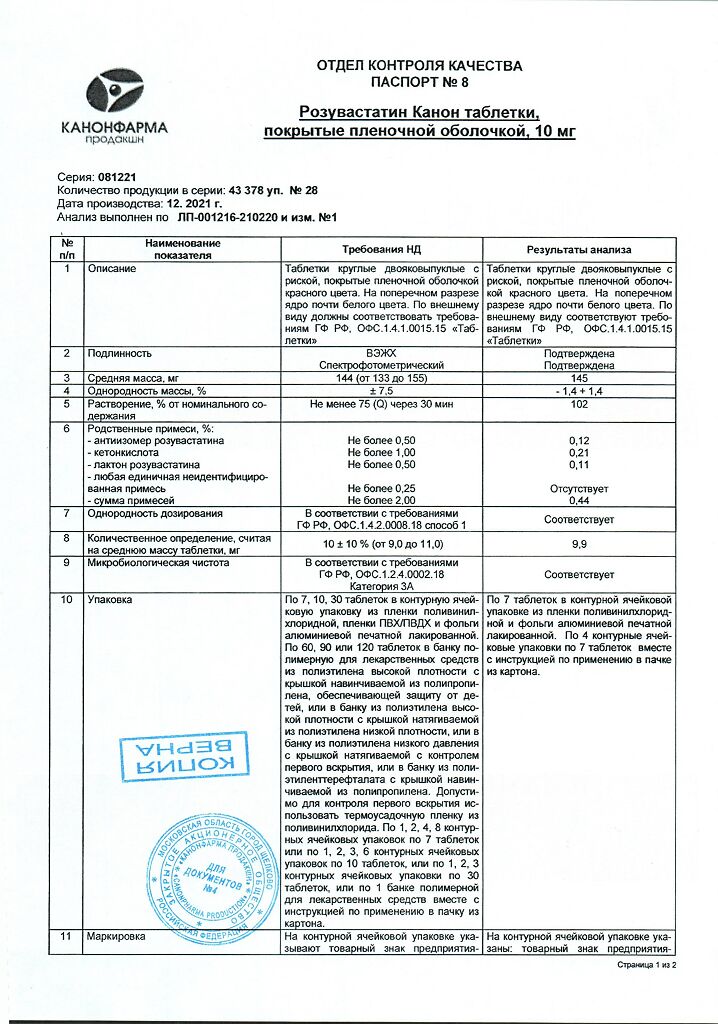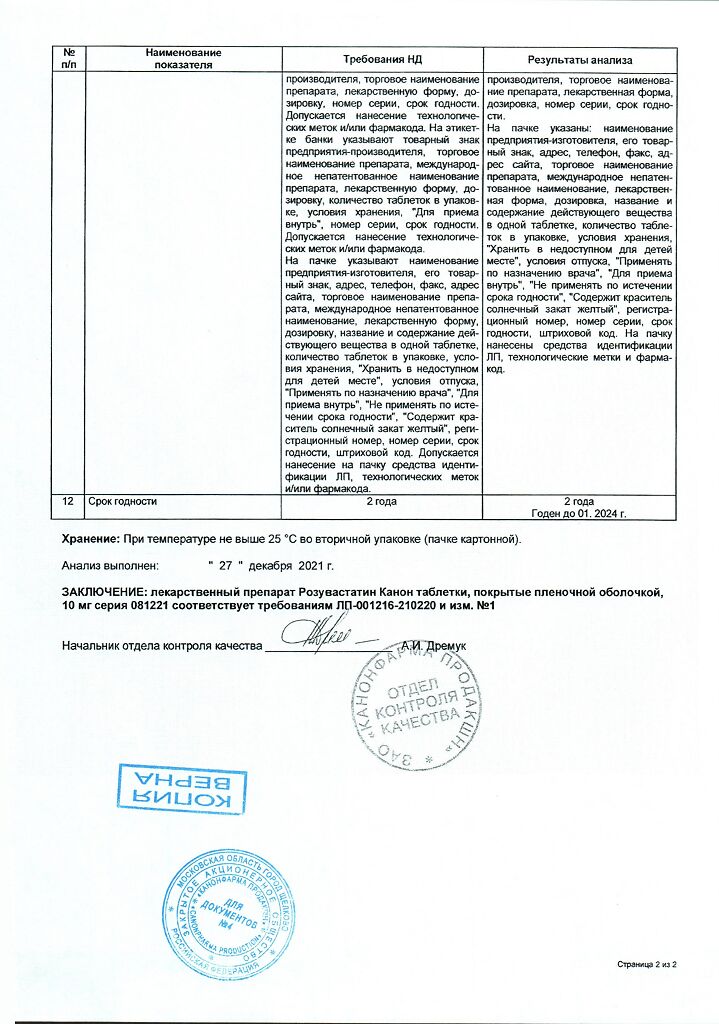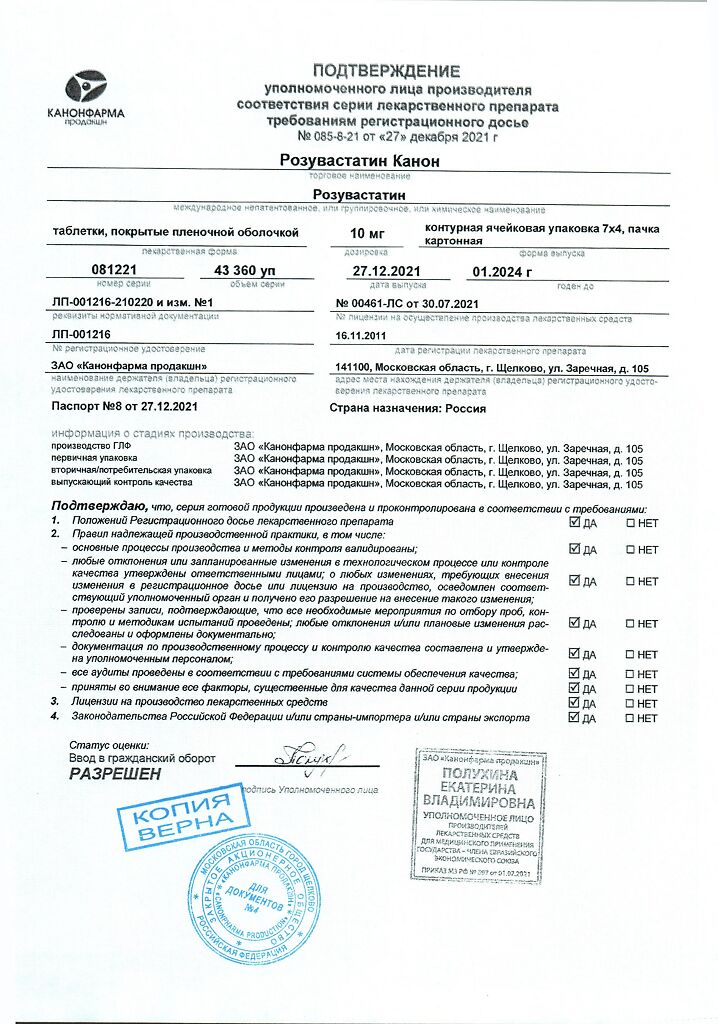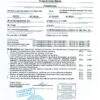No products in the cart.
Rosuvastatin Canon, 10 mg 28 pcs
€1.00
Out of stock
(E-mail when Stock is available)
Description
Hypolipidemic drug from the group of statins, HMG-CoA reductase inhibitor. By the principle of competitive antagonism, statin molecule binds to the part of coenzyme A receptor, where this enzyme is attached. The other part of the statin molecule inhibits the conversion of hydroxymethylglutarate into mevalonate, an intermediate product in the synthesis of the cholesterol molecule. Inhibition of HMG-CoA reductase activity leads to a series of sequential reactions resulting in a decrease of intracellular cholesterol content and a compensatory increase of LDL-receptor activity and corresponding acceleration of LDL cholesterol (Xc) catabolism.
The hypolipidemic effect of statins is associated with a decrease in total Xc levels at the expense of LDL Xc. The decrease in LDL levels is dose-dependent and is exponential rather than linear.
The statins do not affect the activity of lipoprotein and hepatic lipases and have no significant effect on the synthesis and catabolism of free fatty acids, so their effect on TG levels is secondary and mediated through their main effects on reducing LDL-C levels. A moderate decrease in TG levels with statin treatment appears to be due to the expression of remnant (apo E) receptors on the surface of hepatocytes involved in catabolism of LDL, which includes approximately 30% of TG.
In addition to hypolipidemic action, statins have a positive effect in endothelial dysfunction (preclinical sign of early atherosclerosis), on the vascular wall, atheroma condition, improve rheological properties of blood, have antioxidant, antiproliferative properties.
The therapeutic effect is manifested within 1 week after the start of therapy and after 2 weeks of treatment is 90% of the maximum possible effect, which is usually achieved by 4 weeks and thereafter remains constant.
Pharmacokinetics
After oral administration the Cmax of rosuvastatin in blood plasma is reached after about 5 hours. Bioavailability is approximately 20%.
Rosuvastatin is accumulated in the liver. Vd is approximately 134 l. Binding to plasma proteins (predominantly to albumin) is approximately 90%.
It is biotransformed to a small extent (about 10%), being a non-core substrate for cytochrome P450 isoenzymes. The main isoenzyme involved in metabolism of rosuvastatin is CYP2C9. CYP2C19, CYP3A4 and CYP2D6 isoenzymes are less involved in metabolism.
The main identified metabolites of rosuvastatin are N-dismethyl and lactone metabolites. N-dismethyl is about 50% less active than rosuvastatin, lactone metabolites are pharmacologically inactive.
About 90% of the dose of rosuvastatin is excreted unchanged in the feces. The remaining part is excreted with urine. Plasma T1/2 is approximately 19 h. T1/2 does not change when increasing the dose. Mean plasma clearance is approximately 50 l/h (coefficient of variation 21.7%).
As with other HMG-CoA-reducase inhibitors, hepatic uptake of rosuvastatin involves the membrane Xc transporter, which has an important role in hepatic elimination of rosuvastatin.
The systemic exposure of rosuvastatin increases in proportion to the dose.
In patients with severe renal impairment (CK< 30 ml/min), plasma concentrations of rosuvastatin are 3 times higher and N-dismethyl concentrations are 9 times higher than in healthy volunteers. Plasma concentrations of rosuvastatin were approximately 50% higher in patients on hemodialysis than in healthy volunteers.
In patients with hepatic impairment with a grade of 8 and 9 on the Child-Pugh scale, an increase in T1/2 by at least 2-fold was noted.
Indications
Indications
In hypercholesterolemia (type IIa, including familial heterozygous hypercholesterolemia) or mixed hypercholesterolemia (type IIb) as an adjunct to diet, while diet and other non-drug therapies (for example, weight loss, exercise) are not sufficiently effective. Homozygous familial hypercholesterolemia as an adjunct to diet and other cholesterol-lowering treatments or when such treatments are not appropriate for the patient.
Active ingredient
Active ingredient
Composition
Composition
Active substance:
Rosuvastatin calcium;
Associated substances:
calcium hydrophosphate dihydrate,
pregelatinized corn starch,
How to take, the dosage
How to take, the dosage
To the mouth, the tablet should not be chewed or crushed, swallowed whole with plenty of water, it can be taken at any time of the day, regardless of meals. If it is necessary to take the drug in a dose of 5 mg, the tablet with a dose of 10 mg should be divided.
Before starting therapy with the drug Rosuvastatin Canon, the patient should start a standard hypocholesterolemic diet and continue to follow it during treatment. The dose of the drug should be adjusted individually depending on the goals of therapy and the therapeutic response to treatment, taking into account current recommendations for target lipid levels.
The recommended starting dose for patients starting to take the drug or for patients switching from other HMG-CoA reductase inhibitors should be 5 mg (1/2 10 mg tablet) or 10 mg of Rosuvastatin Canon once daily.
If the drug is taken concomitantly with gemfibrozil, fibrates, nicotinic acid at a dose of more than 1 g/day, the recommended starting dose of the drug is 5 mg (1/2 tablet of 10 mg).
When choosing the starting dose, individual cholesterol levels should be guided by the possible risk of cardiovascular complications and the potential risk of side effects should be assessed. If necessary, the dose may be increased to a higher dose after 4 weeks.
. Because of the possible development of side effects when taking a dose of 40 mg, compared with lower doses of the drug, increasing the dose to 40 mg, after an additional dose above the recommended initial dose for 4 weeks of therapy, may only be undertaken in patients with severe hypercholesterolemia and with a high risk of cardiovascular complications (especially in patients with familial hypercholesterolemia), in whom the desired therapy outcome was not achieved when taking the 20 mg dose and who will be under medical supervision. Particularly close monitoring of patients receiving the 40 mg dose is recommended.
The 40 mg dose is not recommended in patients who have not previously seen a physician. After 2-4 weeks of therapy and/or when increasing the dose of the drug, monitoring of lipid metabolism parameters is necessary (dosage adjustment is required if necessary).
Interaction
Interaction
Cyclosporine: in concomitant use of rosuvastatin and cyclosporine the AUC of rosuvastatin is on average 7 times higher than the value observed in healthy volunteers. Co-administration with rosuvastatin leads to an 11-fold increase in plasma Cmax. Does not affect the plasma concentration of cyclosporine.
Vitamin K antagonists: initiation of therapy with rosuvastatin or increasing the drug dose in patients receiving simultaneously vitamin K antagonists (e.g., warfarin) may lead to an increase in prothrombin time (International Normalized Ratio – INR). Cancellation of rosuvastatin or reduction of the drug dose may lead to a decrease of INR (INR control is recommended).
Gemfibrozil and other hypolipidemic agents: co-administration of rosuvastatin and gemfibrozil leads to a 2-fold increase in Cmax and AUC of rosuvastatin. Based on the data on specific interaction, no pharmacokinetic interaction with fenofibrates is expected, pharmacodynamic interaction is possible.
Gemfibrozil, fenofibrate, other fibrates and lipid-lowering doses of nicotinic acid (high doses or equivalent 1 g per day) increase the risk of myopathy when used concomitantly with HMG-CoA reductase inhibitors, possibly due to the fact that they can also cause myopathy when used in monotherapy. In concomitant use of the preparation with gemfibrozil, fibrates, nicotinic acid at a dose more than 1 g/day the initial dose of the preparation of 5 mg (1/2 tablet of 10 mg) is recommended for patients.
Ezetimibe: Simultaneous use of rosuvastatin and ezetimibe was not accompanied by changes in AUC and Cmax of both drugs.
HIV protease inhibitors: despite the fact that the exact mechanism of interaction is unknown, co-administration of HIV protease inhibitors may lead to a significant increase in exposure of rosuvastatin. A pharmacokinetic study of concomitant administration of 20 mg rosuvastatin with a combination drug containing two HIV protease inhibitors (400 mg lopinavir/100 mg ritonavir) in healthy volunteers resulted in approximately twofold and fivefold increases in AUC (0-24) and Cmax of rosuvastatin, respectively. Therefore, concomitant administration of rosuvastatin and HIV protease inhibitors in patients with human immunodeficiency virus (HIV) is not recommended.
Antacids: concomitant use of rosuvastatin and suspensions of antacids containing aluminum and magnesium hydroxide leads to a decrease in plasma concentration of rosuvastatin by about 50%. This effect is weaker if antacids are used 2 hours after taking rosuvastatin. The clinical significance of this interaction has not been studied.
Erythromycin: Concomitant use of rosuvastatin and erythromycin decreases AUC of rosuvastatin by 20% and Cmax by 30%. This interaction may result from increased intestinal motility caused by erythromycin.
Oral contraceptives/hormone replacement therapy: concomitant use of rosuvastatin and oral contraceptives increases AUC of ethinylestradiol and AUC of nogestrel by 26% and 34%, respectively. This increase in plasma concentration should be considered when selecting a dose of oral contraceptives. There are no pharmacokinetic data on concomitant use of rosuvastatin and hormone replacement therapy, therefore, a similar effect cannot be excluded when using this combination.
Other drugs: no clinically significant interaction of rosuvastatin with digoxin is expected.
Cytochrome P450: Results of in vivo and in vitro studies have shown that rosuvastatin is neither an inhibitor nor an inducer of cytochrome P450 isoenzymes. In addition, rosuvastatin is a non-core substrate for these isoenzymes. No clinically significant interaction between rosuvastatin and fluconazole (inhibitor of CYP2C9 and CYP3A4 isoenzymes) and ketoconazole (inhibitor of CYP2A6 and CYP3A4 isoenzymes) was observed. Co-administration of rosuvastatin and itraconazole (CYP3A4 isoenzyme inhibitor) increases the AUC of rosuvastatin by 28% (clinically insignificant). Thus, no interaction associated with metabolism through the cytochrome P450 system is expected.
Special Instructions
Special Instructions
Use with caution in the presence of risk factors for rhabdomyolysis (including renal failure, hypothyroidism, personal or family history of hereditary muscle disease and previous history of muscle toxicity when using other HMG-CoA reductase inhibitors or fibrates), chronic alcoholism, in patients over 65 years of age, with a history of liver disease, sepsis, arterial hypotension, extensive surgery, trauma, severe metabolic endocrine or electrolyte disorders, uncontrolled epilepsy, in persons of Asian origin (Chinese, Japanese).
The therapy should be discontinued if the CPK level is significantly increased (more than 5 times the IGN level) or if muscle symptoms are severe and cause daily discomfort (even if the CPK level is 5 times less than the IGN level).
When using rosuvastatin at a dose of 40 mg, it is recommended to monitor renal function parameters.
In most cases proteinuria decreases or disappears during therapy and does not indicate acute or progressive existing renal disease.
An increase in myositis and myopathy has been reported in patients taking other HMG-CoA reductase inhibitors in combination with fibrin acid derivatives (including gemfibrozil), cyclosporine, nicotinic acid, azole antifungals, protease inhibitors and macrolide antibiotics. Gemfibrozil increases the risk of myopathy when concomitantly prescribed with some HMG-CoA reductase inhibitors. Thus, concomitant administration of rosuvastatin and gemfibrozil is not recommended. The risk/benefit ratio of co-administration of rosuvastatin and fibrates or niacin should be carefully weighed.
Liver function tests should be performed before therapy and 3 months after the start of therapy. Rosuvastatin should be discontinued or the dose should be reduced if serum transaminase activity is 3 times greater than BHN.
In patients with hypercholesterolemia due to hypothyroidism or nephrotic syndrome, therapy for underlying diseases should be performed before starting treatment with rosuvastatin.
Impact on driving and operating machinery
Patients should be aware that dizziness may occur during therapy when engaged in potentially hazardous activities.
Contraindications
Contraindications
Side effects
Side effects
The central nervous system: often – headache, dizziness, asthenic syndrome; very rare – polyneuropathy, memory loss.
The digestive system: often – constipation, nausea, abdominal pain; rarely – pancreatitis; very rare – jaundice, hepatitis; unspecified frequency – diarrhea.
Respiratory system: unspecified frequency – cough, shortness of breath.
Musculoskeletal system: common – myalgia; rare – myopathy (including myositis), rhabdomyolysis with or without acute renal failure; very rare – arthralgia.
Urinary system disorders: proteinuria (less than 1% of cases for 10 mg and 20 mg doses, 3% of cases for 40 mg doses); unspecified frequency – peripheral edema; very rare – hematuria.
Endocrine system disorders: type 2 diabetes mellitus.
Allergic reactions: rare – hypersensitivity reactions, including angioedema; infrequent – skin itching, rash, urticaria; unspecified frequency – Stevens-Johnson syndrome.
Laboratory indices: Transient dose-dependent increase in creatine phosphokinase (CPK) activity (if CPK activity increases more than 5 times the upper limit of normal, therapy should be temporarily suspended); reversible transient dose-dependent increase in “hepatic” transaminases; increase in glucose concentration, bilirubin, gamma-glutamyl transpeptidase activity, alkaline phosphatase, changes in thyroid hormone levels.
When using some HMG-CoA reductase inhibitors (statins) the following side effects have been reported: depression, sleep disorders, including insomnia and “nightmares” dreams, sexual dysfunction. Single cases of interstitial lung disease have been reported, especially with long-term use of the drugs.
Overdose
Overdose
The pharmacokinetic parameters of rosuvastatin do not change when multiple daily doses are administered simultaneously.
The treatment of overdose is symptomatic, control of liver function and CPK activity is necessary; there is no specific antidote, hemodialysis is ineffective.
Pregnancy use
Pregnancy use
The drug is contraindicated in pregnancy, lactation and under 18 years of age
Similarities
Similarities
Additional information
| Shelf life | 2 years |
|---|---|
| Conditions of storage | In a dry, light-protected place at a temperature not exceeding 25 °C |
| Manufacturer | Kanonfarma Production ZAO, Russia |
| Medication form | pills |
| Brand | Kanonfarma Production ZAO |
Related products
Buy Rosuvastatin Canon, 10 mg 28 pcs with delivery to USA, UK, Europe and over 120 other countries.





















